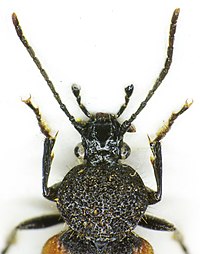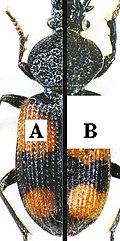Marsh crusaders
| Marsh crusaders | ||||||||||||
|---|---|---|---|---|---|---|---|---|---|---|---|---|

Marsh crusaders |
||||||||||||
| Systematics | ||||||||||||
|
||||||||||||
| Scientific name | ||||||||||||
| Panagaeus cruxmajor | ||||||||||||
| ( Linnaeus , 1758) |
The swamp cross-runner or cross-spotted scarecrow ( Panagaeus cruxmajor ) is a beetle from the family of ground beetles (Carabidae). There are two very similar-looking species of the genus , but they differ significantly in their environmental requirements.
features
The beetles reach a body length of 7.5 to 9 millimeters. The black body is about two and a half times as long as it is wide, the greatest width it reaches in the last third of the elytra. It is only moderately arched and dense, light and finely haired.
The head is stretched forward and much narrower than the pronotum . The eyes are hemispherical and outstanding (Fig. 1). The eleven-limbed antennae are thread-shaped and finely hairy from the 4th limb. They are dark, only the last links are brownish red. The feelers are turned in behind the base of the upper jaw in front of the eyes. The upper lip is short and rounded (Fig. 8a). The upper jaw is short, with a bent tip and without a tooth (Fig. 8b). The jaws are elongated, the end phalanx is cut off at an angle (Fig. 2, Fig. 8c). The chin is three-toothed, the middle tooth has two columns (Fig. 8d left). The end link of the lip switch is also trimmed at an angle (Fig. 8d).
The pronotum is rounded and edged on the side. It is wider than long, but narrower than the elytra . It is very irregularly structured and somewhat wider than the more rounded pronotum of the two-spot crusader ( Panagaeus bipustulatus ) (Fig. 6, above).

|

|
| Fig. 4: Front view | |

|
|
| Fig. 1: Head and breast shield | Fig. 5: Bottom |

|
|
| Fig. 2: side view | |

|
|
| Fig. 3: Section of the underside of the body, right side partially colored orange: rear breast yellow : rear hip green: 1. Abdominal sternite turquoise: trochanter of the hind leg blue: thigh of the hind leg |
Fig. 6: Comparison of P. cruxmajor (B) and P. bipustulatus (A) |

|
|
| Fig. 7: Larva according to Reitter |
| Figure 8: Mouth parts according to Reitter |
||

|

|

|
| a. Upper lip | b. upper jaw | c. Lower jaw |

|
||
| d. Chin and lower lip with lip button viewed from below left, right from above |
||
The wing covers widen a little up to the last third, then they are rounded together. They carry longitudinal rows of point pits. They have four very large orange-red spots, so that the basic black color of the wing can be seen as a dark cross. Since the swamp crusader is on average slightly larger than the two-spot crusader, the species name cruxmajor (Latin crux = cross, major = larger) is explained . Front spots and back spots are separated by a wide wavy to jagged band, on the side a narrow, dark seam strip separates the spots from one another. In contrast to P. bipustulatus, the posterior spots reach the outer edge of the wing covers (Fig. 6, bottom). The label is triangular and clearly visible.
The abdomen has 6 visible segments on the underside ( abdominal sternite ). The first abdominal sternite (Fig. 3, right green) is largely covered by the rear hips (Metacoxa, Fig. 3, right yellow). The rear hips are firmly connected to the rear breast (Fig. 3, right orange) and widened in a plate-like manner on the inside. There they protrude beyond the first segment of the abdomen.
The legs are relatively poorly developed for ground beetles. The tarsi are all five-part (tarsi formula 5-5-5). In the male, the first two segments of the tarsi are enlarged. The thigh ring (trochanter) of the hind legs (Fig. 3, right turquoise) is large and protruding, as is usual with ground beetles. The middle chest surrounds the hip cavities of the middle pair of legs laterally (hidden in the picture).
Similar species
- Two-spot crusaders ( Panagaeus bipustulatus )
Occurrence
The animals are found in the Palearctic . In the north it is found in the south of Norway , central Sweden and Finland . They are also found in England and Ireland . They live in damp biotopes, such as on the banks of water or in damp forests and on wet meadows . You can find them under stones or between moss and leaves. They are rare.
Way of life
The adults hatch in autumn and overwinter. They have a life expectancy of around one year. Like all species of the Panagaeinae subfamily, they can give off an unpleasant odor when in danger.
literature
- Jiři Zahradnik, Irmgard Jung, Dieter Jung et al .: Beetles of Central and Northwestern Europe. Parey, Berlin 1985, ISBN 3-490-27118-1
- Ekkehard Wachmann , Ralph Platen, Dieter Barndt: Ground beetles - observation, way of life. Naturbuch-Verlag, Augsburg 1995, ISBN 3-89440-125-7
- H. Joy, KW Harde, GA Lohse: Die Käfer Mitteleuropas , Vol. 9. Spectrum Academic Publishing House in Elsevier, Munich 1966, ISBN 3-8274-0683-8
- Carl Gustav Calwer and Gustav Jäger (eds.): CG Calwer's Käferbuch . K. Thienemanns, Stuttgart 1876, 3rd edition
